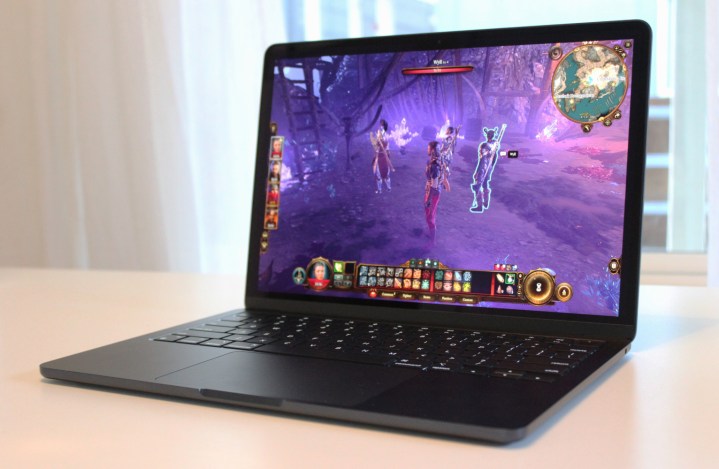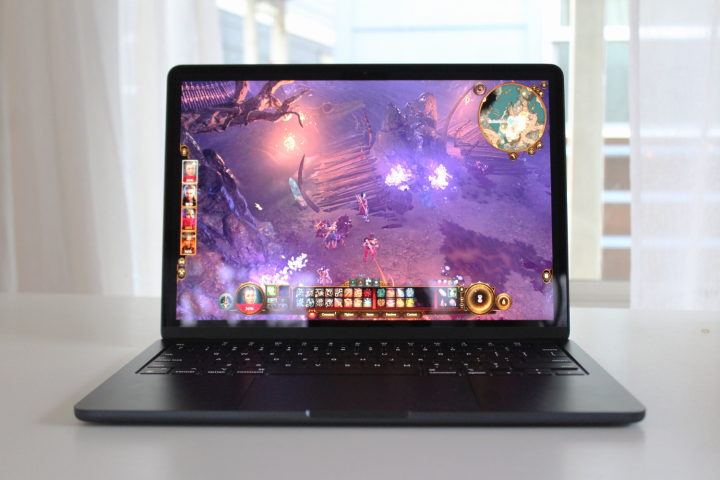
The first laptops in Microsoft’s new Copilot+ PC initiative are rolling out, running Windows on Arm and built around Qualcomm’s Snapdragon X Elite Arm chipset. One of the first is the HP OmniBook X, which also introduces HP’s new brand pulling together all its consumer laptops.
These machines are aimed primarily at Apple’s MacBook Air, which uses the Apple Silicon M3 Arm chipset and has provided the best balance between performance and battery life. Is the OmniBook X a serious competitor?
Specs and configurations
| Apple MacBook Air M3 | HP OmniBook X | |
| Dimensions | 11.97 inches x 8.46 inches x 0.44 inches | 12.32 inches x 8.8 inches x 0.56-0.57 inches |
| Weight | 2.7 pounds | 2.97 pounds |
| Processor | Apple M3 (8-core) | Qualcomm Snapdragon X Elite X1E-78-100 |
| Graphics | 8 GPU cores 10 GPU cores |
Qualcomm Dreno |
| RAM | 8GB 16GB 24GB |
16GB |
| Display | 13.6-inch 16:10 Liquid Retina IPS 2560 x 1664 | 14.0-inch 16:10 2.2K (2240 x 1400) IPS |
| Storage | 256GB SSD 512GB SSD 1TB SSD 2TB SSD |
512GB 1TB |
| Touch | No | Yes |
| Ports | 2 x USB-C with Thunderbolt 4 1 x 3.5mm audio jack 1 x MagSafe 3 |
1 x USB-A 3.2 1 x USB-C 3.2 1 x USB4 3.5mm audio jack |
| Wireless | Wi-Fi 6E and Bluetooth 5.3 | Wi-Fi 6E and Bluetooth 5.3 Wi-Fi 7 and Bluetooth 5.4 |
| Webcam | 1080p | 5MP with infrared camera for Windows 11 Hello facial recognition |
| Operating system | macOS Sonoma | Windows 11 on Arm |
| Battery | 52.6 watt-hours | 59 watt-hour |
| Price | $1,099+ | $1,150+ |
| Rating | 4 out of 5 stars | 3.5 out of 5 stars |
HP offers just two configurations with the OmniBook X. Both use the Qualcomm Snapdragon X Elite X1E-78-100 chipset, and you’ll pay $1,150 for 16GB of RAM and a 512GB SSD and $100 more for a 1TB SSD. A 14.0-inch 2.2K IPS display is the only option.
The MacBook Air M3 has a more complicated configuration. The least expensive model is $1,099 for an 8-core CPU/8-core GPU M3 chipset, 8GB of RAM, and a 256GB SSD. You’ll spend $100 more for a 10-core GPU, and for 24GB of RAM and a 2TB SSD, you’ll spend over $2,000.
Overall, the OmniBook X is more affordable than the MacBook Air M3.
Design

The OmniBook X doesn’t depart too widely from HP’s typical design, with a kind of mash-up of the premium Spectre and midrange Envy aesthetics. It’s an all-metal chassis and lid that’s reasonably rigid, with just some slight bending in the lid under moderate pressure. Its available in two colors, Meteor Silver and Ceramic White, and overall, it’s a good looking if somewhat conservative laptop.
The MacBook Air M3 has Apple’s latest rather boxy, but incredibly meticulous design, giving it a highly recognizable and elegant aesthetic. It’s machined from a solid chunk of aluminum, but like the OmniBook X, the lid is a bit flexible. It can be had in four colors, including Midnight, Starlight, Space Gray, and Silver. I wouldn’t pick either of these laptops over the other based on build quality or aesthetics alone.
In terms of their input options, the MacBook Air M3 wins out. Its Magic Keyboard has larger keycaps, more key spacing, and snappier, more precise switches, while the OmniBook X’s switches are a bit firmer. The MacBook’s Force Touch haptic touchpad is the best you can buy, and it’s much better than the OmniBook X’s mechanical touchpad. It’s larger, more precise, and more customizable.
Neither laptop has a ton of ports, but the MacBook Air benefits from Thunderbolt 4 and a dedicated MagSafe 3 power supply connection, while the OmniBook X makes do with an additional legacy port. It has a USB4 port that mostly matches Thunderbolt 4’s capabilities, but not quite. You can get the latest Wi-Fi 7 on the OmniBook X, while the MacBook Air M3 is limited to one generation earlier.
Finally, the OmniBook X has a higher-resolution webcam and an infrared camera for Windows 11 Hello facial recognition, and it also can utilize some advanced AI features as part of the Copilot+ platform. That includes enhanced Microsoft Studio Effects software with AI-assisted background blurring and more. The MacBook has a Touch ID fingerprint reader, and Apple Intelligence AI features will be rolling out in the next version of macOS Sequoia.
Performance

The OmniBook X uses the Qualcomm Snapdragon X Elite X1E-78-100 Arm chipset. It has 12 cores (eight performance and four efficient) and runs at up to 3.4GHz. It doesn’t have the dual-core burst mode that the faster Snapdragon X Elite chipsets enjoy, making it the slowest in the lineup. Its Adreno GPU runs at 3.8 TOPS (Trillions or Tera Operations Per Second), and like all members of the line, its Neural Processing Unit (NPU) runs at 45 TOPS. The MacBook Air M3 uses the Apple Silicon M3 chipset with eight CPU cores (four efficient and four efficient) and either eight or 10 GPU cores.
In our benchmarks that run natively on Windows on Arm, the OmniBook X was about 12% faster in Geekbench 6 multi-core and 25% faster in Cinebench 2024 multi-core. The MacBook Air M3 was about 30% faster in Geekbench 6 single-core and 40% faster in Cinebench 2024 single-core. In the one graphics benchmark that runs natively on both chipsets, the MacBook Air M3 was about 31% faster.
Ultimately, each of these chipsets is more than fast enough for the most demanding productivity workflows. The MacBook Air M3 has faster graphics, which should make it a better gaming laptop — but only when running older titles or newer titles with graphics turned way down. In creative applications, the MacBook Air M3 will be faster thanks to CPU optimizations in video encoding and decoding. But neither laptop will be a great choice for demanding creators.
| Geekbench 6 (single/multi) |
Cinebench 2024 (single/multi) |
3DMark Wild Life Extreme |
|
| Apple MacBook Air M3 (M3 ) |
3,102 / 12,078 | 141 / 601 | 8,098 |
| HP OmniBook X (Snapdragon X Elite X1E-78-100) |
2,377 / 13,490 | 101 / 749 | 6,165 |
Display and audio

The OmniBook X has a 14.0-inch 16:10 2.2K (2240 x 1400) IPS display. That’s not as sharp as the MacBook Air’s 13.6-inch 16:10 2560 x 1664 IPS panel.
According to our colorimeters, the MacBook Air M3’s display is a lot brighter and has significantly wider colors. The OmniBook X’s colors are slightly more accurate, and both laptops have around the same contrast.
Overall, the MacBook Air M3’s display is better, particularly for creators and media consumers.
| Apple MacBook Air M3 (IPS) |
HP OmniBook X (IPS) |
|
| Brightness (nits) |
495 | 325 |
| AdobeRGB gamut | 87% | 78% |
| sRGB gamut | 100% | 100% |
| DCI-P3 gamut | 99% | 79% |
| Accuracy (DeltaE, lower is better) |
1.24 | 0.98 |
| Contrast ratio | 1,480:1 | 1,400:1 |
The OmniBook X has two downward-firing speakers that are just OK. The MacBook Air M3’s audio is much better, with four speakers putting out louder and clearer sound.
Portability

The MacBook Air M3 is one of the thinnest laptops you can buy today at just 0.44 inches and considerably slimmer than the OmniBook X at 0.57 inches. The OmniBook X is also slightly heavier. Neither laptop is a lot to carry around, but the MacBook Air M3 is noticeably more svelte.
The biggest battle between these two laptops is in battery life, where Qualcomm and Windows on Arm are meant to make the most impact. The OmniBook X is competitive with the MacBook Air M3 when looping our test video, lasting for 22 hours compared to the MacBook at around 19.5 hours. However, when web browsing, the MacBook Air M3 is a lot stronger at 19.5 hours compared to 13.5 hours. And when running Cinebench 2024, the MacBook Air lasts 3.5 hours while the OmniBook X shuts down after around two hours.
The bottom line is that the MacBook Air M3 is a lot more efficient when running more demanding tasks. That means that for real-life work, Apple Silicon retains its top spot.
A step in the right direction, but not far enough
The OmniBook X is a significant improvement over Intel’s Meteor Lake chipsets, with stronger performance and better battery life. It’s reasonably priced, well built, and is a good first member of HP’s new brand. As a Windows alternative to the MacBook Air, it’s certainly worth considering.
On the other hand, the MacBook Air M3 is still a much more efficient laptop, with better battery life, especially as you ramp up performance. It also has a better display, keyboard, and touchpad. It’s more expensive, but in my experience, totally worth it. Some other Copilot+ laptops fare better, such as the Surface Laptop 7th Edition, but in this matchup, the MacBook Air will make more people happy.




